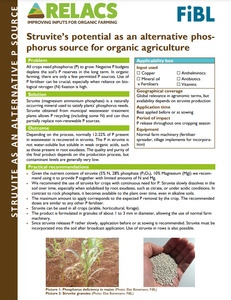{Tool} Struvite’s potential as an alternative phosphorus source for organic agriculture (RELACS Practice abstract). Creator(s): Bünemann-König, Else. Issuing Organisation(s): FiBL - Research Institute of Organic Agriculture, IFOAM Organics Europe. RELACS Practice abstract, no. 07. (2021)
|
PDF
- Published Version
- English
(Struvite’s potential as an alternative phos-phorus source for organic agriculture)
212kB | |
![[thumbnail of 2023-01-09 14_50_03-Struvite’s potential as an alternative phos-phorus source for organic agricultur.png]](/40053/3.hassmallThumbnailVersion/2023-01-09%2014_50_03-Struvite%E2%80%99s%20potential%20as%20an%20alternative%20phos-phorus%20source%20for%20organic%20agricultur.png)  Preview |
Image (PNG)
- Cover Image
- English
219kB |
Document available online at: https://relacs-project.eu/wp-content/uploads/2021/05/RELACS_PA_07_struvite_FiBL_final.pdf
Summary in the original language of the document
Outcome
Depending on the process, normally 12-22% of P present in wastewater is recovered in struvite. The P in struvite is not water-soluble but soluble in weak organic acids, such as those present in root exudates. The quality and purity of the final product depends on the production process, but contaminant levels are generally very low.
Practical recommendations
• Given the nutrient content of struvite (5% N, 28% phosphate (P2O5), 10% Magnesium (Mg)) we recommend using it to provide P together with limited amounts of N and Mg.
• We recommend the use of struvite for crops with continuous need for P. Struvite slowly dissolves in the soil over time, especially when solubilised by root exudates, such as citrate, or under acidic conditions. In contrast to rock phosphate, it becomes available to the plant over time, even in alkaline soils.
• The maximum amount to apply corresponds to the expected P removal by the crop. The recommended doses are similar to any other P fertiliser.
• Struvite can be used in all crops (arable, horticultural, forage).
• The product is formulated in granules of about 1 to 3 mm in diameter, allowing the use of normal farm machinery.
• Since struvite releases P rather slowly, application before or at sowing is recommended. Struvite must be incorporated into the soil after broadcast application. Use of struvite in rows is also possible.
| EPrint Type: | Practice tool |
|---|---|
| What problem does the tool address?: | All crops need phosphorus (P) to grow. Negative P budgets deplete the soil’s P reserves in the long term. In organic farming, there are only a few permitted P sources. Use of P fertiliser can be crucial, especially when reliance on bio-logical nitrogen (N) fixation is high. |
| What solution does the tool offer?: | Struvite (magnesium ammonium phosphate) is a naturally occurring mineral used to satisfy plants’ phosphorus needs. Struvite obtained from municipal wastewater treatment plants allows P recycling (including some N) and can thus partially replace non-renewable P sources. |
| Country: | Switzerland |
| Type of Practice Tool: | Practice abstracts |
| Keywords: | phosphorus, fertilizers, organic agriculture, magnesium ammonium phosphate, Struvite, wastewater |
| Agrovoc keywords: | Language Value URI English phosphorus http://aims.fao.org/aos/agrovoc/c_5804 English fertilizers http://aims.fao.org/aos/agrovoc/c_2867 English organic agriculture http://aims.fao.org/aos/agrovoc/c_15911 |
| Subjects: | Crop husbandry > Composting and manuring |
| Research affiliation: | European Union > Horizon 2020 > RELACS Switzerland > FiBL - Research Institute of Organic Agriculture Switzerland > Crops > Composting and fertilizer application > Fertilizer application Switzerland > FiBL - Research Institute of Organic Agriculture Switzerland > Soil > Nutrient management International Organizations > International Federation of Organic Agriculture Movements IFOAM > IFOAM Organics Europe European Union > Organic Farm Knowledge |
| Horizon Europe or H2020 Grant Agreement Number: | 773431 |
| Related Links: | https://relacs-project.eu/wp-content/uploads/2021/05/RELACS_PA_07_struvite_FiBL_final.pdf, https://www.fibl.org, https://organic-farmknowledge.org/de/tool/40053, https://www.facebook.com/organicfarmknowledge/posts/276099597636015, https://twitter.com/farm_knowledge/status/1404726766187470851 |
| Project ID: | ofk |
| Deposited By: | Forschungsinstitut für biologischen Landbau, FiBL |
| ID Code: | 40053 |
| Deposited On: | 14 Jun 2021 09:55 |
| Last Modified: | 02 May 2024 10:31 |
| Document Language: | English |
| Status: | Published |
Repository Staff Only: item control page


